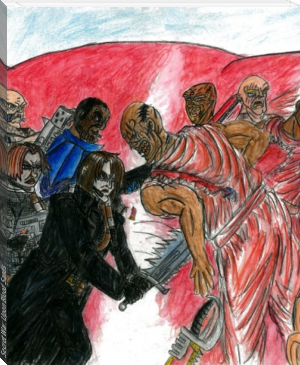Sasquatch by Mike Nassau (books to read to be successful .TXT) 📖

- Author: Mike Nassau
Book online «Sasquatch by Mike Nassau (books to read to be successful .TXT) 📖». Author Mike Nassau
Sasquatch
by Mike Nassau
Dr. Malcolm X Goins was more than a little surprised at being summoned (well, it was worded as an invitation) to see the Director of National Security. He was the chairman of the Genetics Department at Walter Reed Hospital, a Phi Beta Kappa graduate of Fisk University with his M.D. from Meharry Medical College and Ph.D. in genetics from Howard University, and he was highly respected in medical genetics and well known for his research on different forms of HIV (Human Immunodeficiency Virus). While defending the people of America from AIDS could be seen as a form of national security, it had never brought him into contact with the cloak and dagger crowd watching for assassins, saboteurs and other terrorists. So it was with much curiosity and a little anxiety he went to see the formidable Dr. Wheat, an attractive woman known for her ability to think on her feet and to defend the defective policies and asinine comments of the president.
He was shown into her office very nearly at the appointed time and was introduced to two scientists who were with her. She wasted no time on social niceties, and did not give him any more information than necessary. She explained they needed to have a tissue sample analyzed to determine what it was, whether it was human or some other animal, and, if human, what race, but that the work must be absolutely secret and that the results could never be released. Could he do a DNA study on it by himself, letting no one else know what he was doing? He said that he could do so, but it would take more time than if he could get his technicians to help. She replied that time was not so critical as was absolute secrecy, so he agreed to do it by himself. He was presented with a small vial with a sample of liver tissue and he went back to Walter Reed.
As he ground up a small amount of the liver and extracted the DNA from it, he wondered what the sample could be from. How could it be that they didn't know even if it was human or not and yet need to know as a matter of national security? He didn't come up with an answer until he started to get results from selected polynucleotide sequences. They showed great similarity to known human sequences, but were not the same. Comparing them with chimpanzee sequences, they showed about half as much divergence from human nucleotide order as from the chimpanzee. This told him the sample was hominid, but not modern human, that it was from a hominid which had been separated from the ancestral line leading to modern humans for some three million years. If he was working on a hair embedded in amber, like the mosquitoes in Jurassic Park with dinosaur DNA in them, he would understand better, but this was a fresh liver sample. Of course, fresh liver samples had been obtained from long extinct Mammoths found frozen in Siberia, but that was from some 10,000 years ago, not three million.
Then he realized that the amount of divergence would mean six million years if the sample were from an ancestor, that the three million years represented three million years of change by both modern humans and the unknown hominid since they were separated, just as the six million years separation from chimpanzees meant that much change by both humans and chimpanzees. Since the sample had the same degree of divergence from the chimpanzee as modern humans do, it obviously was not the common ancestor from six million years ago. So he realized that the sample was from a hominid which had survived to the present but which had diverged from modern humans about three million years ago, probably either the Sasquatch of North America or the Yeti of Asia. While sighted many times, both creatures were doubted to really exist by most of the scientific community. They were regarded as myths or fables, not real flesh and blood animals, but he had a sample of liver from some hominid which was not known to exist. This was when the secrecy requirement to which he had been sworn really began to grate on him.
He made his report to Dr. Wheat just one week after he was given the sample. He explained that the degree to which two samples of DNA diverged constituted a biological clock showing how long the lines leading to the animals had been separated. Mutations, changes in the nucleotides present, occurred at a fairly constant but very low rate over time, the more mutations, the longer the separation. The five genetic races of modern humans had only been separated from each other for 200,000 years or less. The original split at that time had the ancestors of two races moving south and the other three going north from somewhere not too far from northwestern Kenya. The two southern races, the Khoisan (Khoikhoi or 'Hottentots' and San or 'Bushmen') and the Twa ('Pygmies', Mbuti) had separated from each other about 150,000 years ago. To the North, the two races of western Africa and the Trans-Saharan race had separated about the same time. In West Africa, the Sahelian race of the grasslands and the Guinean race of the rain forests had separated some 100,000 years ago. The Trans-Saharan race, which included everyone else, northern Africa, the Horn of Africa, Eurasia, the Americas, Australia and Oceania, had diverged greatly in appearance but not in DNA sequences. The separation between Australian natives and Icelanders, between Quechua Indians of the Andes and Ethiopians, or Chinese and the Dravidians of southern India, was less than 60,000 years, too little to be considered more than sub-races. Since this sample showed a divergence of some three million years, it was from a different species, not just a different race. The separation would be at the time of the australopithecines. This meant it was from a hominid unknown to science but which had survived to the present.
Then he begged her to tell him if it was the Sasquatch or the Yeti. She looked at him in a startled, puzzled manner. Then she said she would have to consult others before deciding if he could be told anything more, and had him go to her waiting room while she made some phone calls. When she called him back in a few minutes, she informed him that she was authorized to tell him that the sample was collected in mountains in western United States. He returned to Walter Reed excited to know that he was the first person to ever examine the DNA of a Sasquatch, the elusive hairy wild man of the western forests.
________________________________________________________________________________________________________________
Dr. Wheat met with the rest of the Council to discuss this finding. That it was a hominid of terrestrial origin was actually what she and the others had expected from the autopsy results fifty years earlier. The beings were too similar to modern humans to have originated anywhere but the Earth. They had become known as "grays" to flying saucer enthusiasts and drawings of them were everywhere with their thin bodies and huge, dark eyes. This was because their gray uniforms and large dark monocles had been perceived as their skin and eyes by observers. When these were removed from their dead bodies, they were amazingly like humans to be from a "flying saucer" which had crashed in New Mexico. The autopsies had shown the similarity was internal as well as external. The lack of speech centers in their brains and the shape of their throat and mouth indicated that they vocalized like bonobos and chimpanzees, and did not have spoken language. Their brains were somewhat larger than modern humans in proportion to their small bodies, so they were obviously intelligent, even without the evidence of the technology they had used. But was it their technology?
The consensus of the scientists was that it was not their technology. They were probably the servants or slaves of some more advanced species, used to man space exploration because the master species did not want to be confined in space craft for the many years it took to reach other stars and their planets. They had been taken from Earth some three million years ago, presumably some sort of australopithecines, and kept as slaves, pets or domestic animals by the master species. They had to have been taken from the Earth by some more advanced species since australopithecines could not have traveled to a planet of another star on their own. The information that the grays had been taken from Earth about three million years ago was unexpected. The Scientists in the project had speculated that the grays were humans from Earth who had been modified by selection or genetic engineering by their masters after being captured fairly recently. Their Earth origin had not been doubted by many, however, since the probability of nearly identical forms of life on another planet was virtually zero.
Are they a threat to humans? Is the master species a threat to humans? If the master species decides to use the grays to conquer the Earth and enslave humans, is there any possibility of getting the grays to ally with their human relatives against their masters? The first two questions were pretty impossible to answer, but the third seemed more amenable to analysis. The difference between grays and humans was great. Communication was difficult. They presumably were treated quite well by their masters or they couldn't be trusted to explore at great distances from their home world. For humans to try to recruit grays as allies would be comparable to wolves trying to recruit domestic dogs as allies against humans. Except they had been domesticated for 300 times as long as the dog. It would be very difficult if not impossible, especially in view of the three million year separation.
________________________________________________________________________________________________________________
At a meeting of scientists on a spaceship, 4785 (short for 1053 9224 5802 4785) was trying to get agreement on the report of their findings to be sent to the Masters. Theirs was the third shift, each ship had observed Earth for nearly eighteen years. The report would be received in only about twelve Earth years, but the ship would not get home for some forty years. Many of them would be dead before then, the rest would be old. 4785 asked 9272, the chief biologist, what his conclusions were. 9272 signed that the Earth was indeed the planet from which the Masters had obtained their ancestors, that the humans were very close relatives of the People. There were many similarities that had implications for health maintenance, many medicines both natural and synthetic which would be useful both for People and for the other animals the Masters had imported from Earth. There were some traits which might be introduced into the People by genetic engineering if authorized by the Masters. The human capacity for speech was the most obvious trait, it permitted communication while leaving the hands free for other tasks. The prehensile tail of the spider monkey was another trait he would like to see introduced, it could





Comments (0)